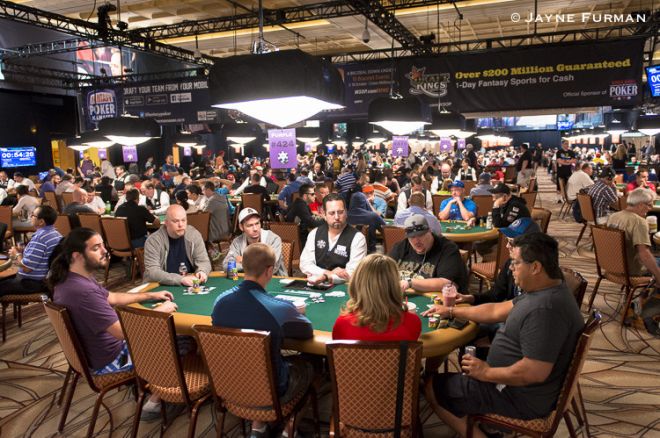Picturing Day 1: A Look at Structures and Stacks for Low Buy-In WSOP NLHE Events

Every year, the World Series of Poker draws a batch of new poker players as well as those who have only entered one or two events in previous years. This year — with low buy-in events like tomorrow’s Colossus (Event #5, $565 entry) at the beginning of the series and the Lucky Sevens at the end (Event #66, $777 entry) — the management at the WSOP is probably hoping for even more players to dip their feet in the water at the Rio.
For years, though, the entry-level tournament at the series has been $1,000 no-limit hold’em. The number of standard $1,000 events is down to just three this year (#22, #30, and #57). Additionally there are $1,000 Turbo NLHE, Hyper NLHE, Seniors NLHE, Super Seniors NLHE, Ladies NLHE, Online NLHE, and pot-limit Omaha tournaments. And there’s the Little One for One Drop, which you can technically enter for $1,000 without paying the optional $111 charity donation, though you’d both label yourself as cheap and cripple yourself by not doubling your starting stack with the chips that come with the donation.
Nevertheless, for players looking for a well-structured event with a large field, these so-called “donkaments” offer the chance at a significant payout for what used to be the smallest buy-in at the WSOP. Let’s take a look at how the first day of one of these low buy-in NLHE events tends to play out in terms of the structure and the stacks.
Levels 1 and 2
The standard $1,000 WSOP events have 60-minute levels, half the length of a Main Event level. Lately they have typically attracted about 2,000 entries and take three days to finish, with the winner usually taking home a bit over $300,000. Mike Kachan, the winner of the last $1,000 NLHE event in 2014, actually won over $400,000 after besting a 2,525-entry field following a grueling 13-hour Day 3.
In recent years, the number of starting chips in most WSOP events was three times the amount of the buy-in — e.g., 3,000 chips for the $1,000 events. But a change this year has increased the starting stacks for many events, with players in the $1K NLHE events now starting with 5,000 chips.
Lest you think that change introduces a lot more room to play in the early going, the other thing that’s been modified for this year are the blind levels. The players who started with 3,000 chips were 120 big blinds deep, starting at 25/25. The new starting stacks of 5,000 chips will actually be 100 big blinds deep to begin, as Level 1 will be 25/50. You’ll get a 20-minute break after level 2 and another after level 4.
Here’s a look at the structure for the first 11 one-hour levels of a $1K event (i.e., what comprises Day 1 of the tournament):
| Level | 2015 SB/BB (ante) | 2015 Cost per Level (approx.) |
|---|---|---|
| 1 | 25/50 | 250 |
| 2 | 50/100 | 500 |
| 3 | 75/150 | 750 |
| 4 | 100/200 | 1,000 |
| 5 | 100/200 (25) | 1,750 |
| 6 | 150/300 (25) | 2,250 |
| 7 | 200/400 (50) | 3,500 |
| 8 | 250/500 (50) | 4,000 |
| 9 | 300/600 (75) | 5,250 |
| 10 | 400/800 (100) | 7,000 |
| 11 | 500/1,000 (100) | 8,000 |
At approximately 30 hands per level and nine-handed tables, the first two levels of the new $1K structure are going to cost each player about 750 chips for the blinds, compared to about 425 in previous years. In other words, the proportion of chips paid for blinds in the first two hours to starting stack size is essentially the same as it was in previous years.
Levels 3 through 6
The ratio of blinded chips to starting stack stays the same as it was in previous years during Level 3, but by the end of the fourth level, the difference in stack sizes in the new structure gives a slight advantage to players. If you haven’t played a hand by now — unlikely after about 120 hands, but let’s pretend you’re very patient — you’ll have lost 50% of your stack under the new structure vs. 58% in previous years.
For this year’s $1Ks, if you’ve lost 60% of your stack at the end of Level 4 for whatever reason, you’ll have less than an hour to build back up before you’re effectively blinded out, because the 1,750 in chips you’ll pay for blinds and antes during the next level will wipe you out.
The transitions between the first four levels contain the greatest rate of increase in the per level chip cost as well as being the end of the point that players who haven’t increased their chip stacks significantly can expect to survive. The dinner break then comes after level 6.
Levels 7 through 10 (or 11)
The seventh hour-long level should begin about 8:10 p.m., after six hours of play, two 20-minute breaks, and a 90-minute dinner. If you’re going to make it through to Day 2, you should expect to be playing through until after 2 a.m. — around six more hours in real time post-dinner (including breaks).
This is the long grind. From Level 1 to Level 4, the big blind increases 300% (from 25/50 to 100/200). By Level 7, the blinds have only gone up 100% since Level 4, but with the addition of antes, the cost per round is still up 250% (approx. 1,050 chips/level at 200/400 and 50 ante).
After another three game hours go by you reach Level 10, where the blinds are 400/800 with an ante of 100, so the approx. cost per round is up only 100%, to 2,100 chips. Under the old structure, the money bubble typically broke somewhere around Level 10 or early in Level 11 — before the end of Day 1 — and this year shouldn’t be too much different.
Median chip stack — where half the players have more and half the players have less — at the end of the day in past events has been almost exactly 33,000, or 11 starting stacks. With the larger starting stack this year, expect players who make it to the end of Day 1 to be centered around the 55,000-chip mark, with the chip average (not the same as the median) slightly above that.
If making the money is important to you, the cost of blinds and antes in Levels 8 through 10 should be a bit over 16K. If you have 35K at the end of Level 7 — an hour after the dinner break — and you go card dead, you can nut up, make the money, and even Day 2, though you’ll be coming in with only 10-15 big blinds and just a couple rounds of hours before you blind out.
If it’s your first WSOP or your 10th or 100th, good luck to everyone about to take on some of the biggest challenges in the poker world!
Want to stay atop all the latest in the poker world? If so, make sure to get PokerNews updates on your social media outlets. on Twitter and find us on both and !








